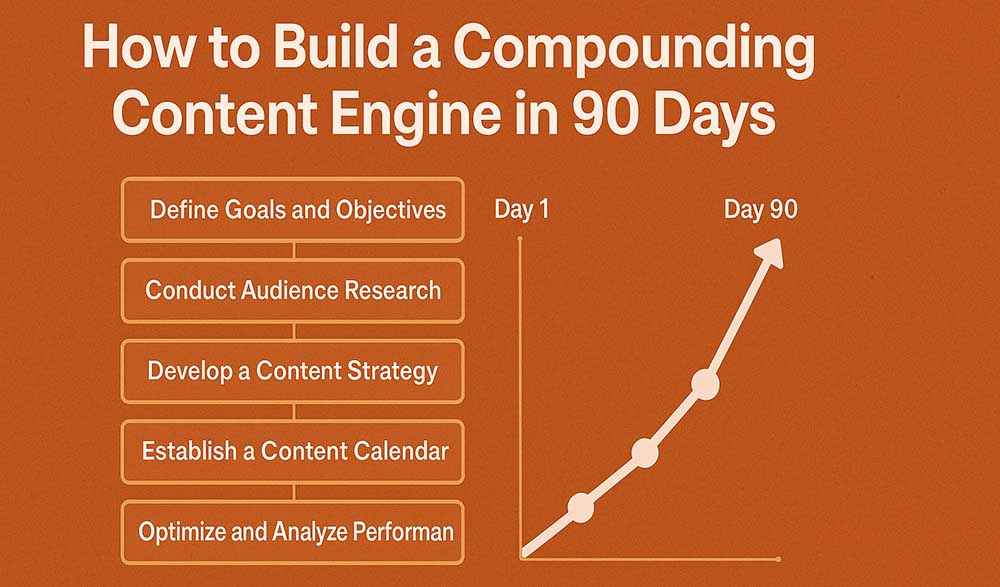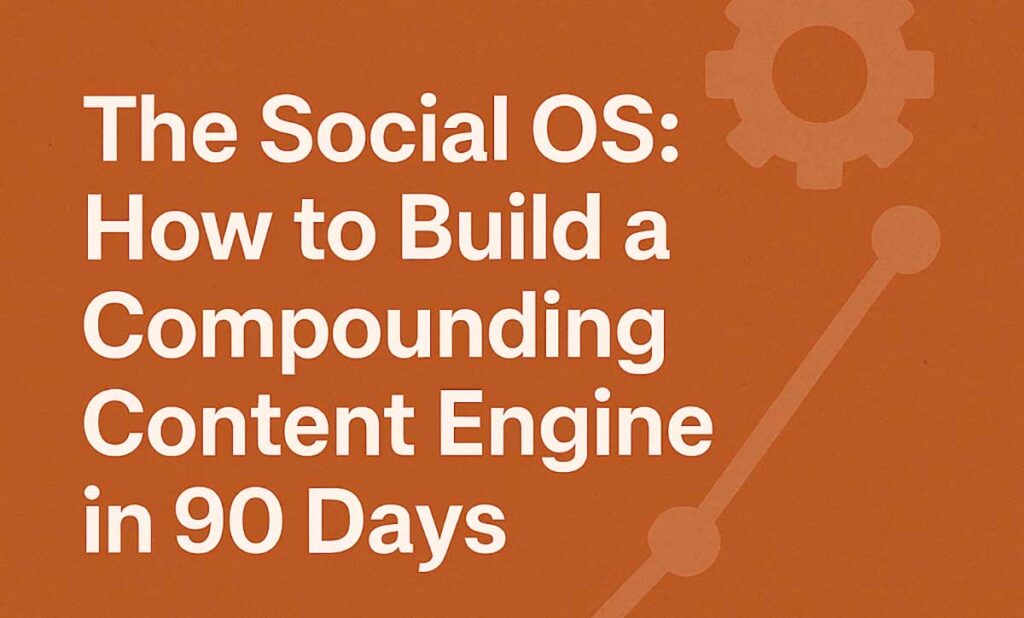Stop Posting. Start Building.
Here’s the uncomfortable truth: most brands are stuck in what I call the “content treadmill.” They churn out posts, chase likes, and hope something sticks. It’s exhausting, and it doesn’t scale.
I’ve sat in too many marketing meetings where the question is, “What do we post this week?” That question is the problem. High-performing social brands aren’t guessing what to post — they’re running a system. A system where every piece of content strengthens the next. Where one campaign doesn’t die after a week, it feeds the library for months.
That’s what I mean by a Social OS: a repeatable, structured operating system for creating, reusing, and scaling social content narratives over time. And if you don’t have one, you’re wasting energy.
How Social Media Got Here (And Why Systems Matter Now)
Back in 2012, Facebook Pages gave brands a golden ticket. I remember managing a hospitality account where a single photo could reach 10,000 people with no spend. Reach was cheap.
Then came Instagram, with its polished visuals, TikTok, with its fast-paced culture, and LinkedIn, with carousels. The environment shifted. Suddenly, you weren’t fighting for reach; you were fighting algorithms that rewarded volume and velocity.
The instinct? “Post more.” But treating content like fireworks — impressive for a second, gone the next — leaves brands drained. The ones who survived built systems that recycled, refined, and scaled content like assets.
Industry studies, such as Hootsuite’s Social Trends report, support this, showing that brands that focus on structured, repeatable content strategies consistently outperform those that rely on scattergun posting.
Why Content Trade-Offs Decide Long-Term Success
- Speed vs. Consistency – Daily posting without a system fragments your brand voice. It feels fast, but in the long term, you lose authority.
- Evergreen vs. Reactive – Trend-hopping makes you visible but forgettable. Evergreen assets compound.
- Energy vs. Burnout – Without a system, teams firefight instead of creating. I’ve seen brilliant marketers quit their roles due to the chaos.
These aren’t workflow problems. They’re brand sustainability problems.
Content Calendar vs Social OS
A common question I get from SMEs and corporate clients in Bournemouth and across the UK: “Isn’t a Social OS just a content calendar?”
Here’s the difference:
| Content Calendar | Social OS |
| Answers “What do we post next week?” | Answers “How does each piece compound for 12+ months?” |
| Format-led: posts, reels, carousels | Narrative-led: stories, proof points, transformation arcs |
| Siloed content creation | Atomisation and re-use across channels |
| Short-term consistency | Long-term equity and compounding growth |
Calendars are tactical. Operating systems are strategic.
A 90-Day Blueprint That Actually Works
| Phase | Focus | What You Do | Hidden Challenge | Real-World Example |
| Weeks 1–2 | Narrative Mapping | Choose 2–3 core brand stories. Validate with customer feedback. | Saying no to weak storylines is harder than it looks. | A gym in Dorset dropped “general fitness” tips and built around “life after 40.” Sign-ups doubled. |
| Weeks 3–4 | Atomisation Rules | Break one long-form piece into 10+ content “atoms.” | Risk of repetition unless you vary hooks. | A SaaS firm turned one webinar into 12 LinkedIn posts, TikTok clips, and emails. |
| Weeks 5–6 | Distribution Loops | Design repost rules across channels. Introduce staff advocacy. | Needs governance or it slips off-brand. | A UK agency templated LinkedIn posts for staff. Reach doubled. |
| Weeks 7–8 | Scoring & Measurement | Track resonance: saves, shares, DMs. Ignore vanity likes. | Patience — not every atom lands. | An e-commerce brand discovered testimonials outperformed polished product shots. |
| Weeks 9–12 | Optimise & Scale | Document workflows, build libraries, train staff. | Risk of rigidity if you kill creativity. | A UK bank codified five winning plays and scaled them nationally. |
By the end of 90 days, you’re not chasing posts. You’re running a compounding machine.
Visualising the 90-Day Social OS
If you prefer to see the system at a glance, this infographic breaks down the 90-day blueprint into a clear step-by-step flow — perfect for sharing with your team or using as a reference while you build your own Social OS.

Ready to Stop Posting Randomly?
At Digital Hype, we help independents, SMEs, and corporates build compounding social systems — not just content calendars. If you’re serious about moving beyond the treadmill, let’s talk about how to get you there.
Discover Social Media OptimisationA Case Study from the Trenches
One consultancy I worked with in Bournemouth was stuck in the “once-a-week LinkedIn” rut. They felt busy, but leads weren’t moving.
We rebuilt their OS around myth-busting advice and client stories. Within three months:
- Output tripled — no new hires.
- Lead-gen posts tied to narratives outperformed generic posts by 2.5x.
- They built an asset library that sales still use today.
The magic wasn’t more posts. It was a system of compounding stories.
Service by Budget: How We Tailor This
- Independent founders & small teams (under £2k/month): Focus on narrative mapping and atomisation. One strong piece → ten smart posts.
- SMEs (£2–10k/month): Add distribution loops, employee advocacy, and resonance scoring. Systems beat volume here.
- Corporate teams (£10k+/month): Build libraries, roll out to branches, and run advanced tests. Challenge shifts from creation to governance.
Wherever you sit, the OS scales with you.
Insider Moves Professionals Use
- File-Naming Conventions: [Narrative]-[Format]-[Date] saves chaos later.
- Resonance Scoring: DMs, saves, and shares matter more than likes.
- Employee Advocacy: Give staff posts to personalise — reach multiplies.
- Content Half-Life: Republish proven winners at 6–12 months.
The Bigger Picture
This isn’t just about social. A Social OS powers:
- Sales teams (reusable proof points)
- PR (evergreen leadership content)
- HR (authentic culture stories)
Social is just the frontline. The OS is the engine.
FAQs
What is a Social OS in marketing?
A Social OS is a structured, repeatable system for creating, reusing, and scaling brand narratives so every piece of content compounds over time.
How long does it take to build a Social OS?
On average, 90 days is enough time to define narratives, atomise content, set up loops, measure results, and optimise workflows.
Isn’t a Social OS just a content calendar?
No. Calendars are tactical schedules. A Social OS is a strategic infrastructure that ensures long-term compounding.
What’s the biggest mistake businesses make?
Chasing short-term trends without building a reusable asset library. It burns out teams and budgets.
Can this work for small businesses?
Yes. Even independents in Dorset or UK-wide can repurpose one strong blog, video, or client story into multiple assets that drive months of value.
Where to Go Next
If you’re ready to step off the treadmill, don’t start with more posts. Start with a system. Explore Social Media Optimisation and the frameworks inside Social Media Strategies.
Because in 90 days, you could still be asking, “What do we post?” Or you could be running a Social OS that compounds value every time you hit publish.


